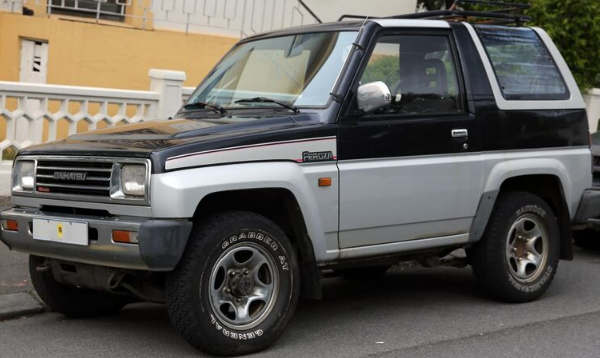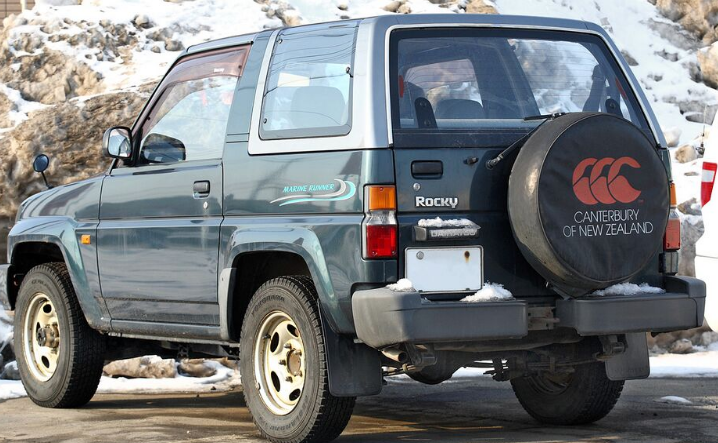
| Version | Summary | Created by | Modification | Content Size | Created at | Operation |
|---|---|---|---|---|---|---|
| 1 | Jason Zhu | -- | 998 | 2022-10-27 01:50:11 |
Video Upload Options
The Daihatsu Rocky (Japanese: ダイハツ・ロッキー, Daihatsu Rokkī) is an automobile nameplate used by Daihatsu for their lineup of SUVs. The nameplate was originally used as a ladder frame-based mini SUV that was sold in Japan and some international markets between 1989 and 2002. It was gradually replaced by the introduction of Terios in 1997. Beginning in 2019, the Rocky nameplate returned to Japan as a subcompact crossover SUV that replaces the Be‣go and is also rebadged and sold under Toyota brand as the Toyota Raize (Japanese: トヨタ・ライズ, Toyota Raizu).
1. Name
For the F300 model, it is known as the Daihatsu "Lovibond" Rocky in Japan. In Europe and Australia, the F300 series Rocky is known as the Daihatsu Feroza, as the name "Rocky" was used for the larger F70 series Rugger/Fourtrak in most countries. The "Feroza" name is also used in Latin America and Asia. In Indonesia, the "Feroza" name was used for the petrol-engined rear-wheel drive version of the Rugger (usually called "Taft" there). The F300 series Rocky was marketed as the Daihatsu Sportrak in the UK.
To avoid confusion, owners often refer to the models by their factory model number F300 or F310. The F310 variant, marketed as the "MkII Sportrak" or "Feroza II" featured a flared guards to accommodate a wider track than the F300 model. The F310 variant was released in 1992, before the later facelift. It had widened suspension, including differentials and rear leaf springs. The body was kept the same, except for the wider fender flares and the concealed rear wheel arches, covered by these flares. After this facelift, both the F300 and F310 variations were kept, with differing trim levels and interior design. This is most notable on the materials, colour and pattern of the seats.
2. First Generation (F300; 1989)
2.1. Design
The Rocky is powered by a 1.6 L HD-C/HD-E SOHC 16-valve four-cylinder petrol engine shared with the Applause.[1] This is linked via a manual or Aisin automatic transmission, propshaft and differential to the front wheels and rear axle to provide either four-wheel drive or rear-wheel drive depending on the driver requirement. 2WD, 4WD Low and 4WD High are selected using a selector next to the gear stick in the cabin. Full-time 4WD with lockable inter-axle differential version were available, but without a low gear in transfer case. Power ranged between 55–77 kW (74–103 hp; 75–105 PS) in Japan. It was available with a three-door bodystyle only, and was one of the first mini SUVs introduced by Japanese manufacturers during the 1980s. The Rocky was one of two models, alongside the Charade, to be sold in the United States during Daihatsu's brief presence in that market.
In Europe, Latin America, Australia and most Asian markets the F300 model was sold as the Daihatsu Feroza. "Feroza" is a made-up name, a combination of "ferocious" and the name "Rosa".[2] The export models were usually fitted with a detuned version of the more powerful fuel injected engine, with 70 kW (94 hp; 95 PS) at 5,700 rpm. There was also a carburetted version in export trim, producing 63 kW (84 hp; 86 PS) at 6000 rpm.[2]
The multi-point fuel-injected engine was available in Australia. The Australian Feroza II SXP variant was available in 1993 although the carburetted model was dropped from the Japanese lineup, with only the 70 / 77 kW (94 / 103 hp; 95 / 105 PS) engine remaining in the lineup. The Rocky/Feroza was gradually replaced in 1998 by the J100 series Terios.
The F300 series Rocky/Feroza underwent some very minor facelifts during its production, mostly limited to different grilles with early cars having a chromed unit. The taillights were mounted in the bodywork, but some cars had blinds in these spaces and instead carried their taillights in an enlarged rear bumper. This was due to legislation introduced in some markets regarding the rear pivot door.
In 1990 an electrically powered version called the "Rocky EV" was developed together with the Kansai Electric Power Company, who also purchased 26 of them. Its 20 kW (27 hp; 27 PS) electrical motor could propel the Rocky up to 90 km/h (56 mph) and gave a 200 km (124 mi) range at a steady speed of 40 km/h (25 mph). The four-wheel drive system remained, allowing it to climb a 21 percent slope.[3]

-
1990 Daihatsu Feroza 1.6 EL-II (F300; pre-facelift, Iceland)
-

1992–1993 Daihatsu Feroza SE hardtop (F300GD; first facelift, Australia)
-

1997 Daihatsu Feroza Limited hardtop (F300B; second facelift, Australia)
-

Daihatsu Rocky (Japan)
2.2. Bertone Freeclimber II

Italian manufacturer Bertone built a variation of the Rocky/Feroza powered by a 1.6-liter BMW M40 engine, with 73.5 kW (99 hp; 100 PS), called the Bertone Freeclimber II. There was also a version called "Blue Lagoon", after a perfume by Nicolas de Barry. The Freeclimber was popular in France and Italy in particular, as it was unaffected by the quotas imposed on Japanese imports.
3. Second Generation (A200; 2019)
The Rocky nameplate returned to Japan in 2019 as the replacement for the Be‣go. It was unveiled at the 46th Tokyo Motor Show on 23 October 2019 under "New Compact SUV" name and went on sale in Japan on 5 November 2019.[4][5][6] The design was previewed by the 2017 DN Trec concept.[7] It is based on the Daihatsu New Global Architecture (DNGA) platform.[8] Its development was led by Daihatsu chief engineer Nobuhiko Ono.[6] The A200 series Rocky is also rebadged and sold by Toyota as the Raize which replaced the J200 series Rush.[9] The Raize is differentiated from the Rocky by its front fascia. Both the A200 series Rocky and Raize are only available in Japan.
The A200 series Rocky is powered by a turbocharged 996 cc 1KR-VET inline-three petrol engine that produces 72 kW (97 hp; 98 PS) and 140 N⋅m (100 lb⋅ft) of torque. The engine is mated to a continuously variable transmission. In Japan, the Rocky is offered in L, X, G and Premium trim levels, while the Raize is offered in X, X"S", G and Z trim levels. Each trim level has a four-wheel drive option.
-

2019 Daihatsu Rocky Premium (A200S, Japan)
-

2019 Toyota Raize Z (A200A, Japan)
-

2019 Toyota Raize Z (A200A, Japan)
-

2019 Daihatsu Rocky Premium interior (Japan)
-

Daihatsu DN Trec
3.1. Sales
| Calendar Year | Japan | |
|---|---|---|
| Daihatsu Rocky | Toyota Raize | |
| 2019[10][11] | 7,808 | 16,601 |
References
- Kießler, Bernd-Wilfried (1992), Daihatsu Automobile: Erfahrung für die Zukunft, Südwest, p. 73, ISBN 9783517012254
- Vecchietti, Filippo (January 1989). ""Rocky" compatta" (in Italian). Quattroruote (Milan, Italy: Editoriale Domus) 34 (399): 130-131.
- Kießler, p. 81
- Miyazaki, Makoto (2019-10-23). "ダイハツ、市販予定の「新型コンパクトSUV」をサプライズ公開…東京モーターショー2019" (in Japanese). Japan: IID. https://response.jp/article/2019/10/23/327903.html.
- Tan, Danny (2019-10-23). "Tokyo 2019: Daihatsu previews new compact SUV – is this an early look at Perodua’s D55L B-segment SUV?". Malaysia: Driven Communications. https://paultan.org/2019/10/23/tokyo-2019-daihatsu-previews-new-compact-suv-is-this-an-early-look-at-peroduas-d55l-b-segment-suv/.
- Komatsu, Tetsuya (2019-11-05). "【ダイハツ ロッキー 新型】開発責任者「ダイハツならではの新ジャンルのコンパクトSUV」" (in Japanese). Japan: IID. https://response.jp/article/2019/11/05/328386.html.
- Katana, Satria (2019-10-16). "Daihatsu Rocky & Toyota Rise, Versi Produksi Dari Daihatsu DN Trec!" (in Indonesian). Indonesia: Asia Net Mandiri. https://autonetmagz.com/daihatsu-rocky-toyota-rise-versi-produksi-dari-daihatsu-dn-trec/82230/.
- "DNGA第2弾となる新型コンパクトSUV「ロッキー」を発売" [The new "Rocky" compact SUV released as the second DNGA vehicle] (PDF) (Press release) (in Japanese). Japan: Daihatsu. 2019-11-05. Retrieved 2019-11-05.CS1 maint: unrecognized language (link) https://www.daihatsu.com/jp/news/2019/20191105-1.pdf
- "Toyota Launches the New "Raize" in Japan" (Press release). Japan: Toyota. 2019-11-05. Retrieved 2019-11-05. https://global.toyota/en/newsroom/toyota/29251184.html
- Ono, Masaki (2020-02-08). "【ダイハツが快進撃!】ロッキー兄弟、ルーミー4姉妹車 売れまくりの理由は??" (in Japanese). Japan: Best Car Web. https://bestcarweb.jp/news/entame/125960.
- Ono, Masaki (2020-01-31). "【人気爆発ライズ RAV4の影で大幅減のC-HR…】トヨタSUVで壮絶な共喰拡大中!!" (in Japanese). Japan: Best Car Web. https://bestcarweb.jp/news/entame/123798.




